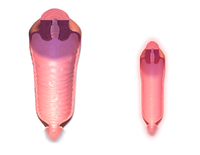
Photo from wikipedia
Introduction and hypothesisPelvic organ prolapse (POP) commonly presents with a “vaginal lump or bulge” and/or a “dragging sensation.” The first symptom correlates strongly with clinical and imaging data. However, a… Click to show full abstract
Introduction and hypothesisPelvic organ prolapse (POP) commonly presents with a “vaginal lump or bulge” and/or a “dragging sensation.” The first symptom correlates strongly with clinical and imaging data. However, a “dragging sensation” may be less specific. Hence, we investigated the predictive value of both symptoms for POP.MethodsThis was a retrospective study involving archived data sets of women seen between November 2013 and May 2014. All underwent a clinical interview, POPQ examination, and 4D translabial ultrasound (TLUS). The main outcome measure was organ descent on clinical examination and TLUS. Offline analysis for organ descent was undertaken blinded against all other data.ResultsA total of 224 women were assessed. Mean age was 57 (23–84) years. Median parity was 3 (0–7). Ninety-three percent (n=208) were vaginally parous. Fifty-eight percent (n=129) complained of symptoms of prolapse: 49% (n=110) of a vaginal lump, 27% (n=61) of a dragging sensation. Clinically, mean point B anterior (Ba) was −0.86 (−3 to +7.5) cm, mean cervical station (C) was −4.1 (−9 to +8) cm, mean point B posterior (Bp) was −1.1 (−3 to +5) cm. On imaging, mean bladder, uterine, and rectal descent were −8.3 (−68.0 to 34) mm, +18.6 (−56.4 to 46.3) mm, and −5.3 (−39.8 to 36) mm respectively. On univariate analysis, both symptoms were strongly associated with objective prolapse clinically and on TLUS, with “vaginal lump” consistently the stronger predictor.ConclusionsThe symptom of a “vaginal lump or bulge” was consistently a stronger predictor of objective POP than “dragging sensation.” This finding was insensitive to adjustments for potential confounders. However, a “dragging sensation” is clearly a symptom of prolapse.
Journal Title: International Urogynecology Journal
Year Published: 2017
Link to full text (if available)
Share on Social Media: Sign Up to like & get
recommendations!